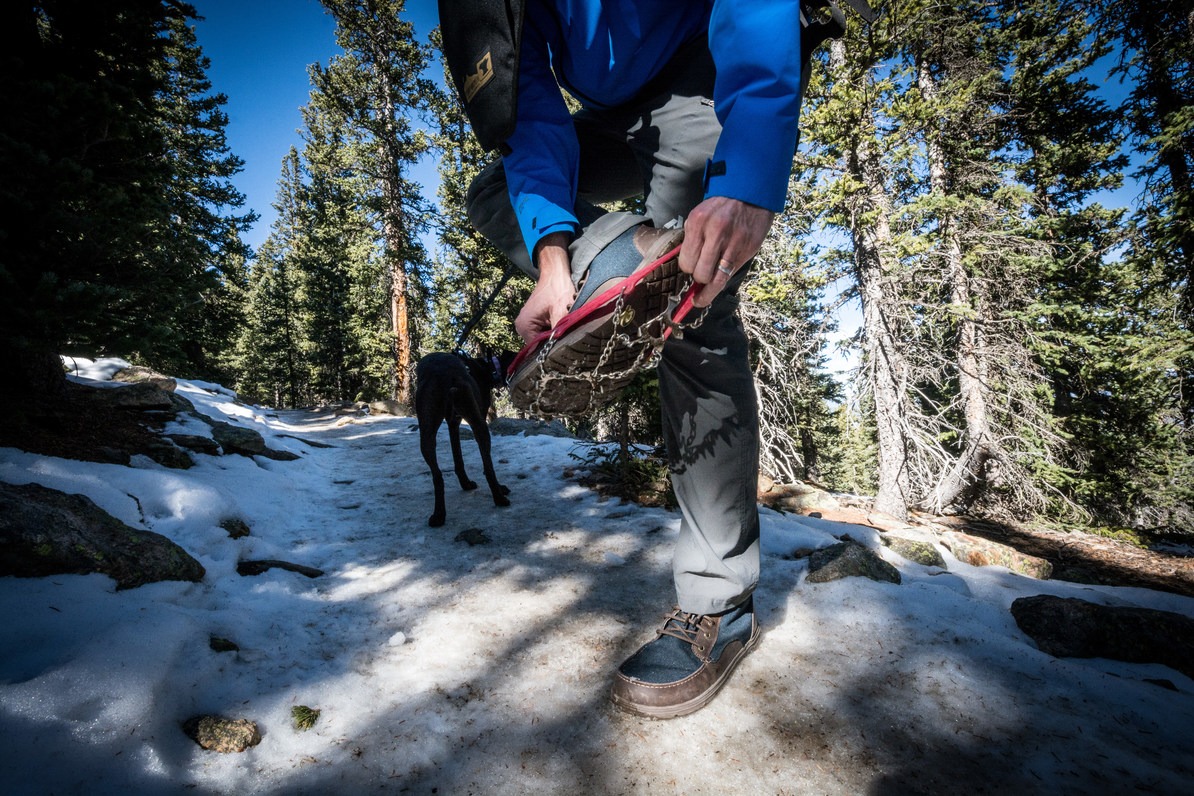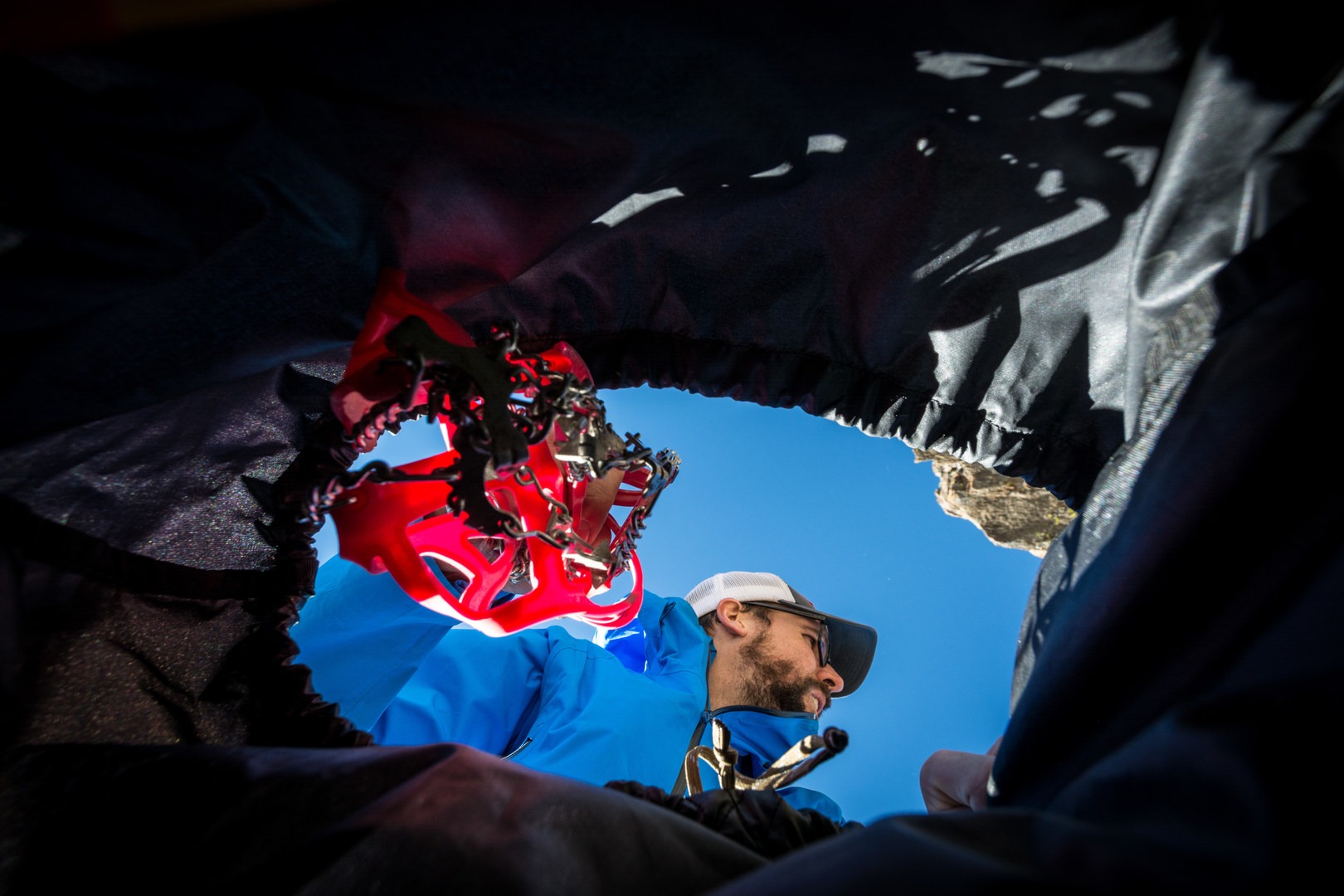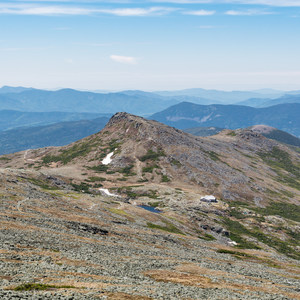Kahtoola MICROspikes specs
- 12 heat-treated stainless steel traction spikes
- Welded chains for durability
- Reinforced eyelets (I wore mine out)
- Raised heel tab for easy on and off
- Durable elastomer band designed to withstand -30 degrees Fahrenheit
- Ice becomes your best walking partner
Where to get it
- Price: $69.99
- Kahtoola
- Amazon
- Backcountry
- Moosejaw
- REI
The Bottom Line: Safety should be top of mind at all times in the outdoors. It does not take much to go wrong, and usually when it does, it happens fast. A little bit of preparedness can make your outing much more enjoyable and safe. The Kahtoola MICROspikes promise just that: a lightweight and convenient traction device that will let you safely continue on your adventure when things get slippery.

Getting some extra traction at the trailhead. Photo by Jason Leach.
When I had first started hiking in the fringe seasons, I had no idea what a traction device was. I was aware of crampons, but I always attributed those to mountaineers and ice climbers, never a lowly hiker who happened to venture into the mountains in late fall. My first hike up the Ammoonosuc Ravine trail to the summit of Mount Washington quickly took a turn that was entirely avoidable had I been more prepared. We were about 2 miles from the trailhead and steadily climbing. There were some ice patches, but we had been able to avoid them. My buddy was just talking about how we might want to each wear one of his studded shoe soles (basically a piece of rigid foam with screws through the bottom). As he was mentioning this, I watched him slip on a smooth section of ice. He grasped for a nearby stick only to have it snap under his weight. Before I could do anything, I watched him slide on his stomach down a long stretch of ice and disappear over a ledge. There was a long moment of silence before I yelled to see if he was okay. A voice emerged from below the ledge letting me know that he seemed fine and that his backpack had broken the fall. I slowly worked my way back down the trail and then cut off trail to find him sitting up in the ravine itself. He took about a 3- or 4-foot drop, and he had landed on his back with his pack taking most of the impact and thankfully protecting his head. A few minutes passed before words were exchanged. He was mostly shaken but otherwise okay. We each strapped on one studded sole so that at least one foot had traction and, for better or worse, continued on to reach the summit that day. The next day I went out and bought a pair of studded soles.
Founded in 1999, Kahtoola's founder had a near death experience on a slide that got him thinking about winter traction. Seeing nothing on the market at the time, he created the Kahtoola KTS crampon, and eventually in 2007 the MICROspike was created. I had kept an eye on the reviews of MICROspikes for a while. My studded soles were doing the trick, and I couldn't justify spending money on something that I already essentially had until I stumbled upon a few reviews that mentioned how easy they were to take on and off. The biggest issue I had with my studded soles was they behaved like a TEVA sandal. You had a bunch of velcro straps to slide into and snug down. From there it would take a bit of adjustment to prevent the sole from sliding around, which was made worse when it got wet, which it always seemed to be. The MICROspike was just metal and rubber...nothing to slide, nothing to adjust, I was sold. I bought my first pair in 2011 and wore them until 2016 when trail running some 4,000 footers in NH I blew out the front eyelet. I used a bit of string and some duct tape to tie it back together, but every few steps it would slide off and I would be walking on a ball of chains and metal. We got out of the woods, and I emailed Kahtoola with a photo. To my surprise, they mailed me a brand new pair, a huge plus when a company stands by their product. I have been using this pair since 2016 and am constantly checking it for wear particularly around the eyelets, so far so good.
At the end of the day, the MICROspike is literally a giant rubber band holding some chains and spikes together. What is so novel about this is it "auto-adjusts" to your shoe. To put it on, you simply slide your toe into the front and use the pull tab on the heel to yank them over the rest of your shoe. The rubber band should take care of the rest. I mention "should" because sizing is something to really consider with these. While they measure in shoe size, you really want to assess what kind of shoe you are using them with. I think the main problem with my first pair was that I had bought and used them primarily with a trail running shoe. A few times I pulled them over a mountaineering boot for a trip, and this is what I think did them in. That is not to say they can't fit around a mountaineering boot, but you might want to size up if that is what you are considering primarily using them with.
If you do any Googling about MICROspikes, you will certainly come across some failure stories. While I cannot account for those stories, I can say that these are not a crampon replacement. If you intend to be traveling on steep angle snow or ice, you should buy a set of crampons. Where MICROspikes excel is low-angle hard-packed snow and very low-angle ice: most trails, and particularly those with switchbacks. A safe thing can quickly become unsafe if you use it wrong. I have used my spikes on hikes in the White Mountains in New Hampshire and the Rockies here in Colorado. Unless you are very familiar with the trail, you may encounter some sections that are beyond the limits of the spikes as I have. While they are recommended for low-angle stuff, they certainly are more safe than hiking without them and can kind of handle steeper grades. It is just not recommended because the spikes are under the foot (no toe points to kick in with).
Wearing the spikes also changes your foot strike target. While usually we seek to avoid ice, with the spikes on I generally feel safer walking on the ice itself. Walking on hard dirt or rock with spikes on is very uncomfortable. Luckily they are easy enough to take off. Throughout a given fringe season trip I am constantly putting my spikes on and taking them off again. It becomes a bit of a rhythm. The fact that I often hike with my dog, who is a strong leash puller, also lends to the necessity of MICROspikes. More than once these have saved me from a fall when my dog decided to give the leash a good jerk.
An important final note about MICROspikes is they need to be sharpened from time to time. I usually work on mine after the season or in the middle of winter. You certainly could pay someone to sharpen them for you, but there is something soothing about taking your time with each point. The bigger issue is that dull points won't work as well as sharp points, and you could suddenly find yourself sliding with your spikes when previously you would not have been. Having witnessed my fair share of accidents in the outdoors, I have worked to put safety over anything else when I head out. Since owning MICROspikes, I have taken more and more notice of folks attempting fringe season adventures without any traction system. Usually it is while I am safely and confidently walking past them while they hover from tree to tree trying to find traction. I think MICROspikes make a simple argument: $70 is way cheaper than a hospital bill, and they are light enough (11 to 14 ounces each, depending on size) to not be a burden if you brought them on a trip and they never left the pack.







Comments
Sign In and share them.